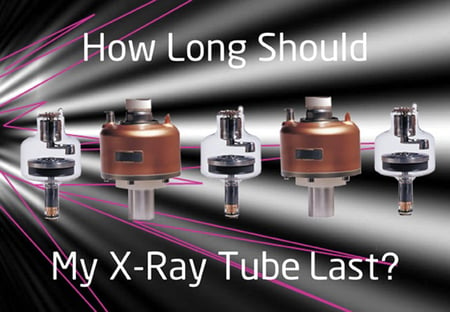Inside every CT system is an X-ray tube. How long that tube will last depends on many factors. With careful, calculated use from an x-ray technologist or radiologic technologist, the average X-ray tube should provide many years of service. There are however many  factors that can shorten the life of an X-ray tube substantially and those factors can typically be controlled by the X-ray tech. So, what can you do to extend and maximize the life of your X-ray tube?
factors that can shorten the life of an X-ray tube substantially and those factors can typically be controlled by the X-ray tech. So, what can you do to extend and maximize the life of your X-ray tube?
Care and Preparation of the X-ray Tube
One step that can help extend the life of an X-ray tube is proper preparation before use. Following the manufacturer’s recommendations, if the tube has not been used for 2 hours or longer, the X-ray tube should be warmed up before use. This helps prevent tube damage due to thermal shock. The process involves typically involves taking several exposures while waiting 30 seconds to a minute between each. Again, we recommend consulting your specific manufactures documentation for time and duration.
Controlling Your Filament Boost and Current
On a basic level, X-ray tube longevity can be extended by applying the minimum recommended current (mA), voltage (kVp) and exposure time that is appropriate to each examination. When the tube current is too high it causes an evaporation of the tungsten from the filament, which is then deposited onto the glass envelope shortening the life of the tube. Lower mA stations and slightly longer exposure times can extend filament life awhile avoiding the factors that lead to unstable operation. This sounds pretty straightforward but it also has another benefit in addition to lengthening the life of your X-ray tube. Employing this strategy can also help improve the speed of image reception because the tube stays in better condition, longer.
Avoiding Damage From Improper Heating and Cooling
There’s a great amount of heat that is generated in the anode of the X-ray tube during a CT scan. Making sure you stick to the manufacturer suggested acceptable levels of operation will help make sure to avoid premature focal track wear or damage. The focal track is one of the most important parts of the CT scanner. Even a moderate pitting of the focal track will result in a falloff in radiation output because electrons from the filament strike this pitted surface and turn into radiation that is absorbed into the surrounding material. Staying within the heating and cooling curves of your X-ray tube also helps prevent more severe melting and damage to the CT scanner from excessive heat transfer such as bearing failure or damage to the rotor body.
Be Aware of Your Rotor Operation
Depending on your CT scanner, knowing the length of time before the rotor brake cycle begins and avoiding long intervals between spot-films can help reduce the heat generated by the stopping and starting process. Additionally when the rotor does stop there should be a minimum of 30 to 40 seconds between the next start up sequence. Obviously machines vary and those with a heat exchanger will be less sensitive to this issue.
Does your X-ray Tube Need Replacement?
- Knowing what to look for can help you spot an X-ray tube in need of replacement.
- Can you see a build up of tungsten deposited on the internal surface of the glass tube window? This deposit will make the X-ray less useful.
- Is the tube producing gas? While gassy tube sounds funny it isn’t. It means your X-ray tube isn’t a vacuum anymore.
- Can you hear oil being sucked into the tube insert when the tube is turned on? That means you have a punctured tube.
- Are there cracks in the tube? Stress fractures can be caused by careless handling and could affect vacuum conditions.
- Is there oil anywhere it shouldn’t be? Could be several issues including the bearings, rotor or the tube housing.
Other X-ray tube conditions are more difficult to detect but there’s one foolproof way to find out the state of your X-ray tube and the status of the CT scanner. Contact Atlantis Worldwide. Our experienced and certified engineers can help you answer questions about your X-ray, CT or MRI machine and get your system up and running, or help it stay running for as long as you need.
Contact Jeff Weiss at 212-366-9100 or jeffweiss@atlantisworldwide.com
Some blogs you may have missed:
- WHY ARE CT TUBES SO EXPENSIVE?
- Do you use Mobile Devices for Medical Imaging?
- Most Interesting Medical Imaging Articles this Year
- CT Scanner Slice: Handy Guide
- 4D CT Scanner: The Future is Here
- Free CT Resources
Meet the author: Vikki Harmonay




